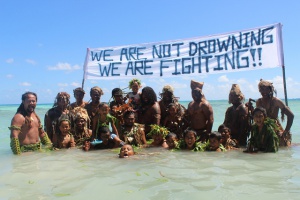Island states work together to fight extreme weather as world prepares for Samoa SIDS conference
Climate |Author: Hajira Amla | August 26, 2014, Tuesday @ 14:16| 8287 views
Tokelau Warriors: We are not drowning. We are fighting. (350.org/Flickr) Photo License: CC BY-NC-SA 2.0
(Seychelles News Agency) - A tiny dot in the centre of the vast blue depths of the Pacific Ocean, Samoa will take centre stage next week as it prepares to play host to heads of state, ministers, private sector businesses, academics, NGOs and journalists from all over the world in a once-in-a-decade United Nations meeting to discuss small island issues.
Seychelles President James Michel will be leading the Indian Ocean island nation to the conference.
Located halfway between Hawaii and New Zealand in the Polynesian island region of the Pacific, Samoa has a population of almost 200,000 and a land mass of 2,800 km², mostly made up of the two main islands, Upolu and Savai'i.
Hand-made banners stretch across roads in various towns to welcome some 3,000 visiting dignitaries from 193 UN member states who are making the long journey for the Third International Conference on Small Island Developing States (SIDS), held between September 1 and 4 in the capital city, Apia.
It is hoped that the conference will boost UN secretary-general Ban Ki-Moon's call for stronger, more concrete measures to counteract climate change. The meeting is the last high-level UN event that is scheduled before the secretary-general’s September Climate Summit and will be an important input into General Assembly discussions in New York.
Small islands weathering the storm
The timing could thus not have been better to launch a global small island partnership called Small Islands, Weather Together campaign, supported by the World Meteorological Organization (WMO), the Secretariat of the Pacific Regional Environment Programme (SPREP) and Digicel Pacific. The project aims to improve weather forecasting and climatology services for all small island developing nations.
According to a press statement issued by the WMO, nations in the Pacific region are increasingly confronted with large numbers of natural disasters, 76 percent of which can be chalked up to weather-related incidents such as cyclones, typhoons, drought and flash flooding.
Sustainable development is often threatened by extreme weather events, as Samoa itself is all too aware. When Cyclone Evan hit the islands in December 2012, a third of the country’s annual economic output was affected.
On the second day of the SIDS conference, selected leaders are expected to convene for a televised panel discussion, facilitated by BBC World journalist and news anchor David Eades, on how small island nations can work together to improve their weather and climate services.
| Youtube Video - Small Islands, Weather Together The “Small Islands, Weather Together” partnership is designed to show how the small island nations of the world are working together to improve their vital weather and climate services. |
Focus on early-warning services
According to the Secretary-General of the WMO, Michel Jarraud, more investment is needed to help small island nations boost their vital weather and climate services and to ensure that their efforts towards sustainable development are not wiped out by disasters.
“If we don’t invest in stronger weather and climate services for small island developing states then extreme weather events could simply wipe out years of development effort if they are not well prepared. It is much more cost-effective to invest in early preparedness and prevention than to focus only on rehabilitation and post-disaster action,” he said.
Early warning systems are the most critical, according to Jarraud. In the Pacific islands, SPREP is working on improving the communication and broadcasting of this type of vital information by forming partnerships with national meteorological services and broadcast media outlets, which together are able to disseminate early warning to the public very quickly.
SPREP Acting Director General KosiLatu says identifying high-risk areas is another area for improvement.
“For example, when planning new infrastructure, we can say ‘this place has a high risk of tsunami, flooding or storm surge, so don’t build things here,” he explained.
Because of their isolation, close proximity to sea level, dependence on tourism and vulnerable economies, SIDS stand to suffer the most should UN member states fail to agree to a limit in greenhouse gas emissions, the main human cause of climate change and global warming.
The tiny Pacific Island nation of Kiribati is a prime example. It is slowly disappearing due to rising sea levels at an average of 3.7 millimeters a year, according to the National Tidal Centre of Australia.
To try to ensure the nation’s continued survival, its president, Anote Tong, announced his plan to purchase almost 6,000 acres of land in nearby Fiji as a last-ditch refuge should Kiribati’s 33 islands start to disappear forever.
“Greenhouse gas emissions are still on the rise. We need to reach a peak of emission over the next 15–20 years, then to decrease dramatically to zero equivalent emission in about 50–60 years from now,” said Jarraud.
“This is a huge challenge. We must act now. The more we wait, the more difficult it will be, and, therefore, the more expensive it will be for countries to adapt to climate change. If we do not act now, we are agreeing to leave the small island developing states in a situation which may no longer be manageable,” he warned.
Back
